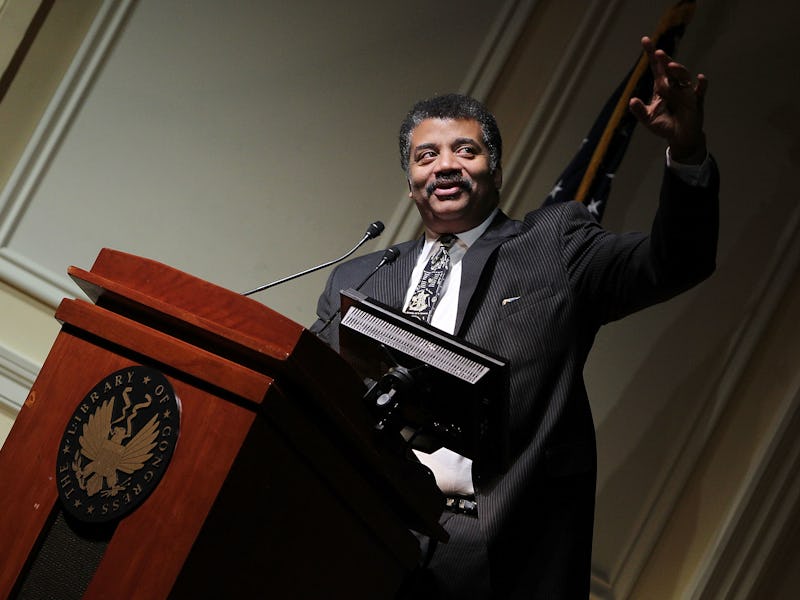Watching the New Horizons Pluto Flyby With Neil deGrasse Tyson
The astrophysicist and other experts monitored the moment together, in awe.

Pluto, improbably, has groupies. When NASA’s New Horizons space probe screamed past Pluto on its historic journey this morning, giving us unprecedented views of the distant dwarf planet, the American Museum of Natural History held a hundred of us, hunkered with Neil deGrasse Tyson and his astrophysicist colleagues to witness history in real time.
I arrived a Pluto enthusiast. But by the time we’d felt the moment of discovery, I might have become a Pluto convert.
The museum’s LeFrak Theater was packed with space brass: Tyson, the director of the Hayden Planetarium, was there; Carter Emmart, the director of astro-visualization at the planetarium; so was Denton Ebel, the museum’s curator of earth and planetary sciences. They were joined on a remote link to the New Horizons mission control located at Johns Hopkins University, who used the theater’s massive IMAX screen to project a detailed approximation of what the craft would be doing as it made its close approach to Pluto at about 7:49 a.m. Eastern.
The craft could wave howdy from its position about 7,800 miles from Pluto’s surface, no small feat of exploration. Its journey began at launch on January 19, 2006, more than nine years and nearly 3 billion miles in the making. Only 85 years after we discovered it — about a third of one of Pluto’s years — humans were venturing out to get a gander at the little frozen rock.
Tyson put the virtual impossibility of the mission thus: “Relative to launching from Earth and coming this close to Pluto would be like hitting a golf ball two miles, and having it land in the cup.” Geologist and geophysics imaging specialist Orkan Umurhan, who was live at mission control, compared it to “threading a needle from New York to L.A.,” which made Tyson laugh. “That’s a better calculation than mine,” Tyson replied.
The mission’s primary goal is to map the small, icy dwarf planet, which up until this morning only looked like a grainy speck. Detailed readouts by the New Horizons will help scientists answer fundamental questions about the geology of its surface, its internal makeup, and the chemistry of its atmosphere. Eventually, the probe will deliver images with a resolution more than a thousand times better than the Hubble uses. This scan of our solar system’s frosty edge could mark a milestone in understanding how any of us came to exist here.
The crowd reached a fever pitch at the announcement of the flyby. The CGI image of the gold foil encrusted space probe neared the icy sphere on the gigantic screen, and digital shadows shooting outwards showed exactly what point New Horizons was supposed to be focusing on.
Umurhan held the room rapt as he described how the craft was rapidly mapping Pluto with swaths of photos. “You can see now the frames that are being taken, and it’s actually happening as we speak,” he said, then caught himself off-guard. “Oh my god,” he said. “This is it — it’s exactly now.” An appreciative roar came up from the crowd. They — mankind, not to put too fine a point on it — had accomplished the fantastic. New Horizons had made its closest approach to Pluto.
Emmart pointed out that what we were seeing on the IMAX screen was only a simulation. “These images are being taken now but the spacecraft is under blackout,” he said. “These images are going to be trickling in later, but this is why we’re doing this event — to sort of show you what’s going on.”
The craft will wait until about 9 p.m. Eastern to send concrete data back to mission control. Until then, the simulated images we saw were only calculations of navigation information that will be used to match the actual images to build the photographic mosaic of Pluto’s surface. Tyson joked about the chance the craft could’ve been lost at sea. “It is entirely possible that this thing got destroyed by alien zappers or rogue asteroids,” he said.
The data lag couldn’t ruin the moment, for which Tyson came prepared. “To see a distant object for the first time is some of the oldest emotions humans have ever had ever since we left the cave,” he said. “What is on the other side of that valley, what is on the top of the mountain? Somebody gets to do that and come back and tell everyone about it.” He concluded: “Given how much we have explored, it’s not everyday when we get to see something for the first time, that has never been seen by another human being. This is a special moment. This is a special day, with nine years of anticipation that led up to it.”